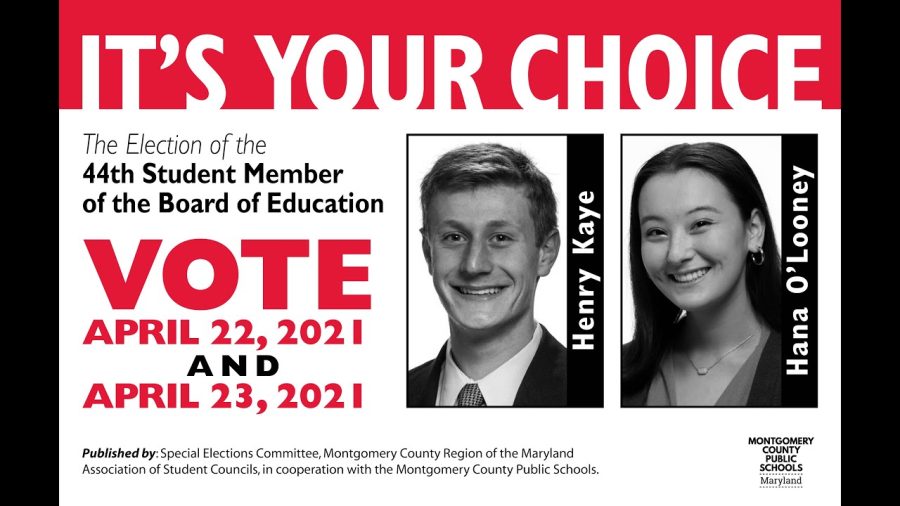SMOB falls short for students
Photo courtesy of MCPS YouTube.
A poster encouraging students to vote for the 2021 SMOB. Voter turnout in past elections has been very concerning, sparking concerns about how much the SMOB truly represents MCPS.
March 17, 2022
A wave of applause swept over the crowd, as the two Student Member of the Board (SMOB) finalists were announced. Cheers radiated from the surviving two campaigns, while frowns and disappointment came from the losing ones. It might not be much consolation to the losing campaigns now – but in its current form, SMOB is an overhyped and mostly-useless position.
First established in 1978, the SMOB has become an increasingly competitive part of an already-competitive county. According to MCPS, “the SMOB can vote on matters related to collective bargaining, capital and operating budgets, and school closings, reopenings and boundaries, but not on negative personnel actions.”
Despite all the problems with the position, Montgomery County is one of two counties in the state to give full voting rights to the SMOB. While it is an improvement from many other counties, the single vote does not go far enough to provide students with serious representation in the county.
The problem stems from the disproportionate amount of voting in the school board – seven adults to one student. The disproportionality manifests itself in non-representative voting totals. On Feb. 1, the board voted to consider transitioning to virtual learning on snow days. Although this was no doubt an issue that a majority of students would oppose, the final voting total was 7-1, in favor of the policy. The only dissenting voice was the SMOB, Hana O’Looney.
In an education system made up of students that are under the age necessary to vote for the board themselves, the position becomes the best direct way to push for issues on a county-wide basis. However, the election process lends itself well to empty promises, leading many candidates to propose large pro-student ideas that have no chance of being passed with only one vote. In past years, candidates have proposed everything from unblocked websites, new schools and an open phone policy for middle school students. These issues may earn a vote in the election, but they stand no chance of being passed because the adults do not support them.
Additionally compounding the issue is the number of students who vote in SMOB elections. Of the 87,751 students eligible to vote in 2021, only 32,917 students voted (37.51 percent). While schools like Poolesville and Richard Montgomery had high voter turnout, WCHS had a voting percentage of 19.81 percent. If the large majority of the county does not vote for SMOB, it is impossible for them to be truly representative.
The issues with SMOB are not on the MCPS board, and they are not on the individual SMOBs themselves. In fact, current SMOB Hana O’Looney has been one of the most influential student voices in MCPS history, and has had multiple great accomplishments on the board – from aiding a successful reopening, to getting free menstrual products in school bathrooms. This does not erase the need for more student representation – with students as passionate about the county as O’Looney, the change that students could make with more representation is infinite.
The change can start from MCPS, but the legislation to increase student representation must come from the state level. Many solutions exist to the issue and increasing the number of student votes to keep up with the adults is a strong one. Multiple SMOBs could come from different areas in the county, giving specific representation to underrepresented areas. Before voting for anyone running for the state legislature, voters should ask candidates how they feel about increasing student voices on the MCPS board.
Another solution would be to allow MCPS students to vote in elections for school board members. Students make up the majority of people within the school system, and along with MCPS staff, bear the result of any decisions made by the school board. It makes sense that adults have a say in the election of the school board, but when students do not get a representative say, the issues can become distant from the board.
The issue of student representation is a complicated one – and many solutions exist. There is no denying that students need more representation on the board, and the county took the first steps in 2016 when they gave the SMOB full voting rights. Everyone came together to let the voices of students be heard. In 2022, we must come together again to let the position of SMOB mean what it stands for – giving students real representation on the board.


